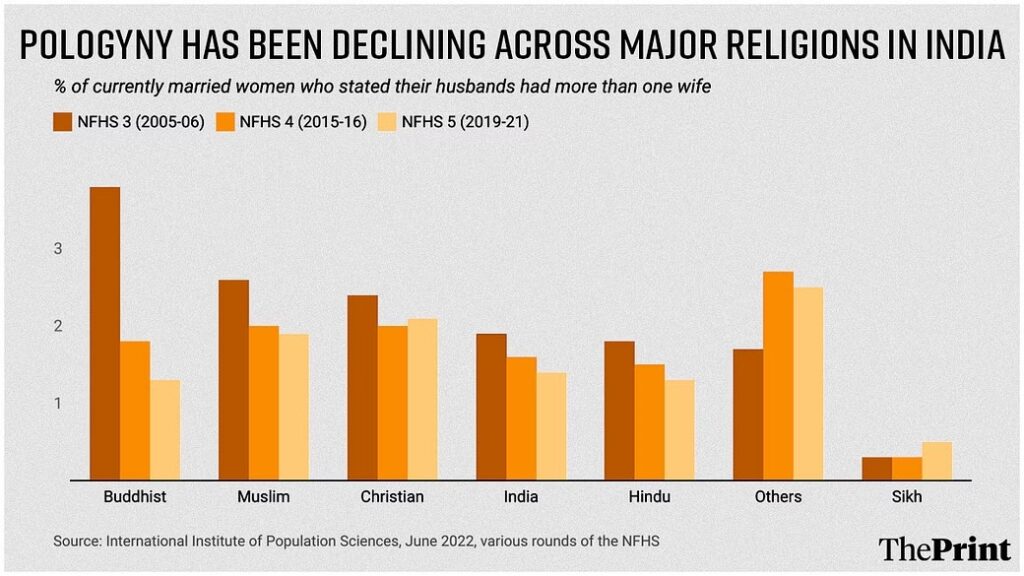Busted! Muslims having multiple wives is an accusation levelled against them far too frequently by right-wing politicians in India. It is part and parcel of the prejudice minorities’ face. However, the data shows that only a small, minuscule number of Muslims practise polygamy. In fact, contrary to popular perceptions, it is not Muslims who have the highest number of polygynous marriages in India.
According to the Indian Express, polygamy was widely practised by communities in India. But it has been on a gradual decline according to existing data. However, somehow prejudices and right-wing campaigns give way for polygamy to be the forte of Muslims in India. However, the recent findings from the National Family Health Survey (NFHS) shed light on the prevalence of polygamy in different communities across India. The data clearly busts all myths about polygamy in India.
Short Dive into History: What does the law say?
Different communities in India are subject to different laws on polygamy.
After gaining independence, provincial legislatures like Bombay and Madras introduced laws against bigamy, including the Special Marriage Act of 1954, which mandated monogamy. The Hindu Marriage Act of 1955 made it illegal to have multiple spouses, extending to Buddhists, Jains, and Sikhs. The Parsi Marriage and Divorce Act of 1936 banned bigamy among Parsis. However, under the Shariat Act of 1937, which governs marriage in Islam, Muslim men are allowed to have up to four wives.
According to the 2019-20 NFHS data, polygamy exists among several religious groups, albeit with varying rates. The analysis, conducted by the International Institute of Population Studies in Mumbai, highlights the overall decline of polygynous marriages and the influence of socio-economic factors on this practice.
Among Hindus, the data reveals that 1.3% engage in polygamy, while the rate stands at 1.9% for Muslims and 1.6% for other religious communities.
Notably, the study emphasises that polygamy is more prevalent among economically disadvantaged, less educated, rural, and older women, suggesting that socio-economic conditions contribute to the occurrence of the practice alongside religion and region.
Noted feminist lawyer and writer, Flavia Agnes has written, in a column for the Indian Express, of how the Law Commission’s Report on Uniform Civil Code notes that although polygamy is permitted within Islam, ‘it is a rare practice Indian Muslims, on the other hand it is frequently misused by person of other religions who convert as Muslims to solely solemnise another marriage.

Over the period from 2005-06 to 2019-20, polygynous marriages decreased from 1.9% to 1.4%. The north-eastern states of Meghalaya and Tripura exhibit higher rates of 6.1% and 2%, respectively. Polygamy is more prominent in states like Bihar, Jharkhand, West Bengal, and Odisha compared to their northern counterparts.
Scheduled Tribes demonstrate the highest prevalence of polygamy, although the trend is declining. In 2005-06, STs reported a rate of 3.1%, which reduced to 1.5% in 2019-20.
Examining religious groups, the study indicates that the “others” category exhibits the highest rate of polygamy at 2.5%, followed by Christians (2.1%), Muslims (1.9%), and Hindus (1.3%). This can be attributed to the prevalence of polygamy in north-eastern states, where Christianity has a significant presence.
The general trend indicates that economic conditions and education levels are key factors influencing the prevalence of polygamy.
In summary, the NFHS data presents a nuanced picture of polygamy in India, showcasing its presence in diverse religious communities while highlighting a declining overall trend. Socioeconomic factors, regional variations, and religious affiliation all contribute to the prevalence of polygynous marriages.
Related:
No! Hindus have not been ‘reduced’ to a minority in 200 districts!
Hate through music, lyrics and visuals: Hindutva pop
Everyday Harmony: Banners asserting fraternity & sisterhood plaster Navi Mumbai streets

